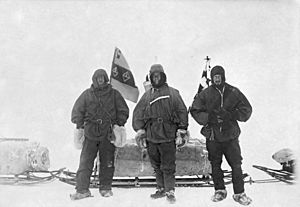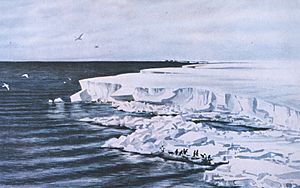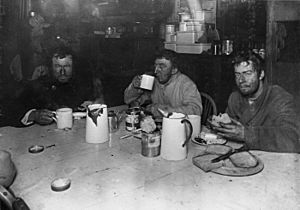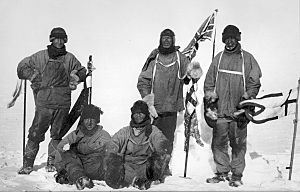Edward Adrian Wilson facts for kids
Quick facts for kids
Edward Wilson
|
|
|---|---|
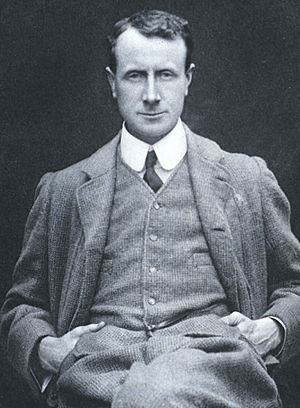 |
|
| Born |
Edward Adrian Wilson
23 July 1872 Cheltenham, England
|
| Died | 29 March 1912 (aged 39) Ross Ice Shelf, Antarctica
|
| Education | Cheltenham College |
| Alma mater |
|
| Occupation | Polar explorer, ornithologist, natural historian, physician, artist |
| Employer | Cheltenham General Hospital |
|
Expeditions
|
|
| Spouse(s) |
Oriana Fanny Souper
(m. 1901) |
| Awards |
|
Edward Adrian Wilson (born 23 July 1872 – died 29 March 1912) was a brave English explorer. He was also a scientist who studied birds and nature. Edward Wilson was a doctor and a talented artist. He is best known for his journeys to the icy lands of Antarctica.
Contents
Early Life and Studies
Edward Wilson was born in Cheltenham, England, on 23 July 1872. He was the fifth child in his family. From a young age, he loved the countryside and nature. He also enjoyed drawing.
He spent a lot of time at his mother's farm. By age nine, he decided he wanted to be a naturalist. His father helped him learn to draw wildlife. In 1891, he went to Gonville and Caius College, Cambridge. There, he studied Natural Sciences and did very well.
During his time at Cambridge, he became a very religious person. He also studied to become a doctor in London. In his free time, he helped people in poor areas. In 1898, he became very sick with a lung illness. He got better after spending months in Norway and Switzerland. During this time, he practiced his art skills. He became a qualified doctor in 1900.
In 1897, he met Oriana Fanny Souper. They got married on 16 July 1901. Just three weeks later, he left for Antarctica.
Adventures in Antarctica
The Discovery Expedition
From 1901 to 1904, Wilson joined the Discovery Expedition. He was the junior doctor, a zoologist (animal scientist), and the expedition artist. They sailed to Antarctica on 6 August 1901. They arrived in January 1902.
On 2 November, Wilson, Robert Falcon Scott, and Ernest Shackleton began a long journey. They wanted to travel further south than anyone before. They had dogs, but the dogs were not well-trained. The dog food was also bad. Many dogs died.
On 31 December, they had to turn back. They had reached 82° 17'S, which was 300 miles (480 km) further south than previous explorers. They were only 480 miles (770 km) from the South Pole.
Shackleton became very ill during the return. Scott and Wilson also struggled. It was a very difficult trip. After 93 days, they returned to the Discovery ship in February 1903. They had traveled 960 miles (1,540 km). Shackleton was sent home early because he was so sick. Later, Shackleton asked Wilson to join another expedition, but Wilson stayed loyal to Scott.
The Terra Nova Expedition
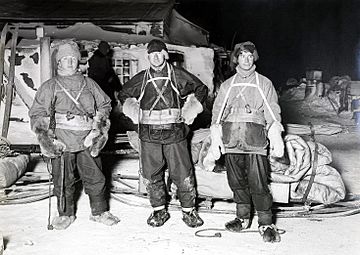
On 15 June 1910, Wilson sailed from Cardiff on the ship Terra Nova. This was Scott's last journey to Antarctica. Wilson was the chief scientist. After many stops, the ship got stuck in ice for three weeks. It finally reached Cape Evans in January 1911.
The team built a base camp hut. Then, they started setting up supply points for the journey to the South Pole. Bad weather and weak ponies caused problems. The main supply point, One Ton Depot, was placed 35 miles (56 km) too far north. This mistake would become very important later.
In the winter of 1911, Wilson led a special trip. He went with Henry Robertson Bowers and Apsley Cherry-Garrard. They traveled to Cape Crozier to find emperor penguin eggs. They needed the eggs for scientific study. The journey was 60 miles (97 km) long. It was almost completely dark, and temperatures dropped to -70°F (-57°C).
They were frozen and tired when they reached their goal. A huge snowstorm hit them. Their tent was blown away by the wind. The men were trapped in their sleeping bags under the snow for a day and a half. When the wind stopped, they luckily found their tent. It was about half a mile away. They collected three eggs. Then, they returned to Cape Evans on 1 August 1911. This trip took five weeks. Cherry-Garrard later wrote a book about it called The Worst Journey in the World.
On 1 November, 14 men began the long trip to the South Pole. Wilson was one of the five men who reached the Pole on 18 January 1912. But they found that the Norwegian explorer Roald Amundsen had already reached it five weeks earlier.
Their journey back became very difficult. They were exhausted and did not have enough food. The weather was also extremely bad. On 17 February, near the Beardmore Glacier, a team member named Edgar Evans died. He had fallen into a deep crack in the ice two weeks before.
Then, on 16 March, Captain Lawrence Oates walked out of the tent into the blizzard. He did this to try and save his friends. His feet were badly frozen. Wilson, Scott, and Bowers continued for three more days. They traveled another 20 miles (32 km). But a blizzard stopped them on 20 March. They were only 11 miles (18 km) from the 'One Ton' food depot. This depot could have saved them.
The blizzard lasted for days. They ran out of fuel and food. They were too weak, cold, and hungry to go on. They died in their tent on or soon after 29 March. They were still 148 miles (238 km) from their base camp.
A search party found their bodies on 12 November 1912. The search team collapsed the tent over them. They buried the men where they lay, under a pile of snow. A cross made from skis marked the spot. When the news reached Britain in February 1913, the country was very sad.
The men on the expedition called Wilson "Uncle Bill." He was a trusted friend to many. People respected his good judgment and his kindness. He was probably Scott's closest friend on the journey. Scott wrote that Wilson was "the finest character I ever met." When their camp was found, Wilson and Bowers were in their sleeping bags. Scott's arm was stretched out towards Wilson.
Legacy and Memory
In 1913, Wilson was given the Royal Geographical Society's Patron's Medal. This was a special award for his work in Antarctica. At Gonville and Caius College, Cambridge, the college flag that Wilson took to the South Pole is kept safe.
Wilson's artwork and things he owned are in several museums. The Scott Polar Research Institute in Cambridge has the largest collection of his art. It has over 200 of his bird paintings and 150 paintings from Antarctica. The museum also shows items like:
- A special flag his wife sewed for him.
- A black flag from Roald Amundsen's expedition. Wilson found it near the South Pole.
- His Patron's Medal from the Royal Geographical Society.
- A candlestick Wilson made from a biscuit tin during the expedition.
Wilson's journal from the Terra Nova expedition is at the British Library. Captain Scott's diary is there too. The Wilson art gallery and museum in Cheltenham has many of his watercolors and drawings.
The ship RRS Discovery, which Wilson first sailed on, is now a museum in Dundee. Visitors can explore it.
A statue of Wilson stands in Cheltenham. Scott's wife, Kathleen Scott, made the statue. It was shown to the public on 9 July 1914. In 2013, the Cheltenham Art Gallery & Museum was renamed 'The Wilson' to honor him. There are also buildings and a school named after him.
In movies, Wilson has been played by different actors. Harold Warrender played him in the 1948 film Scott of the Antarctic. Stephen Moore played him in the 1985 TV show The Last Place on Earth.
See also
 In Spanish: Edward Adrian Wilson para niños
In Spanish: Edward Adrian Wilson para niños


